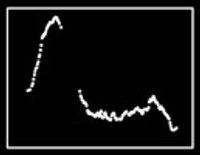Microvariability of Blazars
Pega Team : Research : Resources : Publications : Facilities
One of PEGA's main foci is a study of the variability of AGN across the electromagnetic spectrum, with the goal of understanding the physics of their energy production. Dr. Miller and his students were the first to convincingly establish the presence of microvariability (fluctuations of ~1 % in brightness over timescales of minutes or hours) in the visible band of BL Lac objects and some quasars. PEGA scientists have made great progress in characterizing the frequency and type of rapid variability seen in several classes of AGN, including leading the examinations of radio-quiet QSOs and narrow-line Seyfert 1 galaxies for microvariability. Although our original observational efforts were in the visible band, and most of our current efforts in this area still utilize ground-based optical telescopes, we have broadened our efforts to include observations in the UV, X-ray and Gamma-ray bands using the Hubble Space Telescope (HST) and other space-based observatories such as IUE, RXTE, and CGRO. We will continue to obtain simultaneous measurements in multiple bands since it is of immense importance in distinguishing between hypotheses for the production and processing of radiation. Theoretical efforts in this area have been led by Dr. Wiita, and key contributions to models for rapid variability based on fluctuations in disks of matter accreting onto the central SMBHs have been made by him and collaborators. Simulations of light-curves and polarization variations, as well as power-density-spectra in both optical and X-ray bands are being produced for a wide variety of accretion disk and jet scenarios.
Return to: Pega Team | Research | Resources | Publications | Facilities | Top of page
Questions or comments should be directed to: The Webmaster
Last modified: Tue Oct 12 00:18:57 EDT 2004